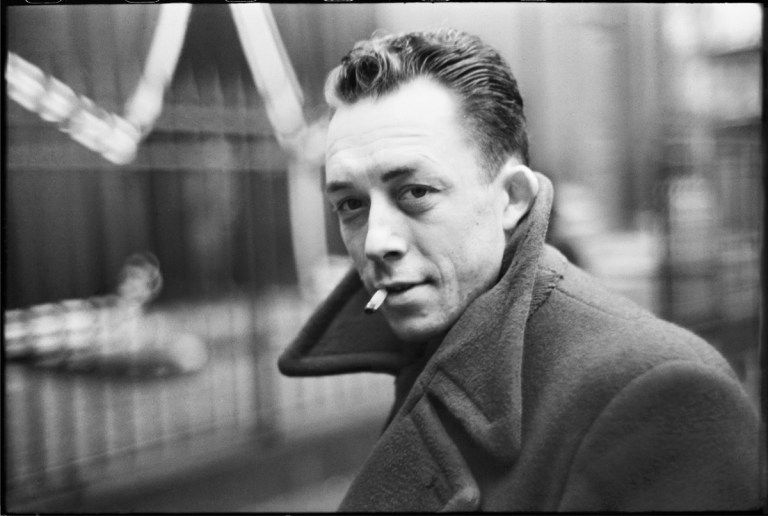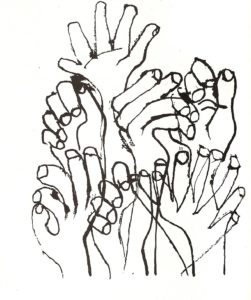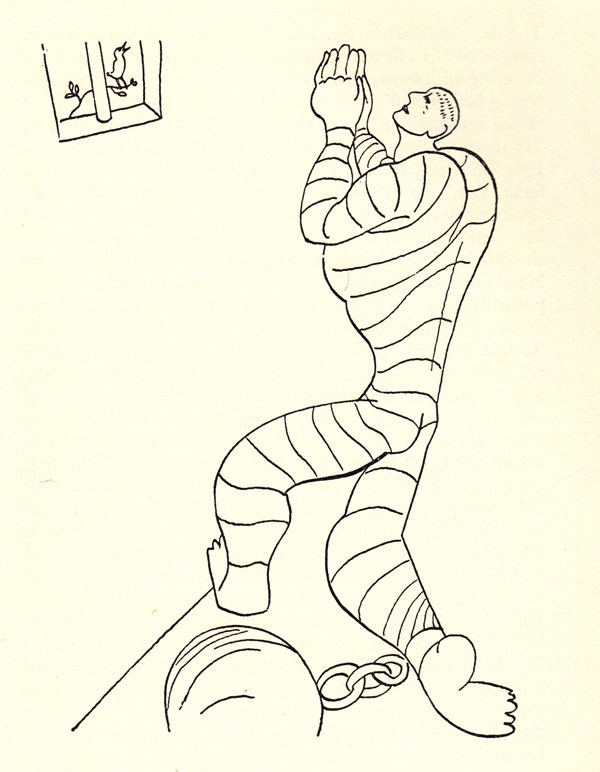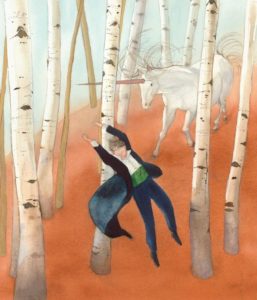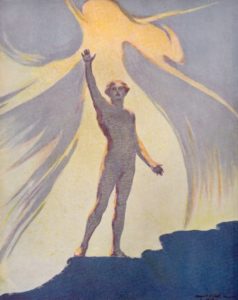Create Dangerously: Albert Camus on the Artist as a Voice of Resistance and a Liberator of Society
INSPIRATIONAL, 18 Mar 2019
Maria Popova | Brain Pickings – TRANSCEND Media Service
“To create today is to create dangerously… The question, for all those who cannot live without art and what it signifies, is merely to find out how, among the police forces of so many ideologies… the strange liberty of creation is possible.”
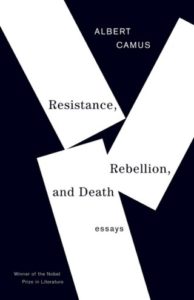 “Those who tell you ‘Do not put too much politics in your art’ are not being honest,” Chinua Achebe observed in his superb forgotten conversation with James Baldwin. “If you look very carefully you will see that they are the same people who are quite happy with the situation as it is… What they are saying is don’t upset the system.” Half a century earlier, W.H. Auden both simplified and amplified this insight when he asserted that “the mere making of a work of art is itself a political act.”
“Those who tell you ‘Do not put too much politics in your art’ are not being honest,” Chinua Achebe observed in his superb forgotten conversation with James Baldwin. “If you look very carefully you will see that they are the same people who are quite happy with the situation as it is… What they are saying is don’t upset the system.” Half a century earlier, W.H. Auden both simplified and amplified this insight when he asserted that “the mere making of a work of art is itself a political act.”
The artist’s essential responsibility to leap society forward by upsetting the system is what Albert Camus (November 7, 1913–January 4, 1960) explores in a timeless, immensely insightful piece titled “Create Dangerously,” composed in Auden’s time but acutely relevant to our own. Originally delivered as a lecture at a Swedish university in December of 1957 — weeks after Camus became the second-youngest laureate of the Nobel Prize in Literature, awarded him for work that “with clear-sighted earnestness illuminates the problems of the human conscience in our times” — it was later included in his indispensable essay collection Resistance, Rebellion, and Death (public library).
Two decades before Audre Lorde called on artists to uphold their responsibility toward “the transformation of silence into language and action,” Camus writes:
An Oriental wise man always used to ask the divinity in his prayers to be so kind as to spare him from living in an interesting era. As we are not wise, the divinity has not spared us and we are living in an interesting era. In any case, our era forces us to take an interest in it. The writers of today know this. If they speak up, they are criticized and attacked. If they become modest and keep silent, they are vociferously blamed for their silence. In the midst of such din the writer cannot hope to remain aloof in order to pursue the reflections and images that are dear to him. Until the present moment, remaining aloof has always been possible in history. When someone did not approve, he could always keep silent or talk of something else. Today everything is changed and even silence has dangerous implications. The moment that abstaining from choice is itself looked upon as a choice and punished or praised as such, the artist is willy-nilly impressed into service. “Impressed” seems to me a more accurate term in this connection than “committed.” Instead of signing up, indeed, for voluntary service, the artist does his compulsory service.
[…]
It is easy to see all that art can lose from such a constant obligation. Ease, to begin with, and that divine liberty so apparent in the work of Mozart. It is easier to understand why our works of art have a drawn, set look and why they collapse so suddenly. It is obvious why we have more journalists than creative writers, more boy-scouts of painting than Cézannes, and why sentimental tales or detective novels have taken the place of War and Peace or The Charterhouse of Parma.
And yet, five years before Baldwin asserted that “a society must assume that it is stable, but the artist must know, and he must let us know, that there is nothing stable under heaven,” Camus insists that there is more to gain than there is to lose in the artist’s commitment to social justice:
To create today is to create dangerously. Any publication is an act, and that act exposes one to the passions of an age that forgives nothing. Hence the question is not to find out if this is or is not prejudicial to art. The question, for all those who cannot live without art and what it signifies, is merely to find out how, among the police forces of so many ideologies (how many churches, what solitude!), the strange liberty of creation is possible.
A century after Emerson scoffed that “masses are rude, lame, unmade, pernicious in their demands and influence [and one must not] concede anything to them, but to tame, drill, divide, and break them up, and draw individuals out of them,” Camus considers the forces that warp creative work and lead to a “surrender of the artist.” In a sentiment of sundering pertinence to our own age of so-called “social media” — that ultimate tyranny of the masses — he writes:
What characterizes our time, indeed, is the way the masses and their wretched condition have burst upon contemporary sensibilities. We now know that they exist, whereas we once had a tendency to forget them. And if we are more aware, it is not because our aristocracy, artistic or otherwise, has become better — no, have no fear — it is because the masses have become stronger and keep people from forgetting them.
Coupled with various other social forces, this tyranny of popular opinion works “to discourage free creation by undermining its basic principle, the creator’s faith in himself.” (Writing in the same era, E.E. Cummings captured the importance of protecting that basic principle beautifully in his advice to artists: “To be nobody-but-yourself — in a world which is doing its best, night and day, to make you everybody else — means to fight the hardest battle which any human being can fight.”) Out of this syphoning of creative freedom and courage, Camus argues, arises the dangerous falsehood that art is merely a luxury. Nearly two decades after Rebecca West insisted in the midst of WWII that “art is not a plaything, but a necessity… not a decorative adjustment, but a cup into which life can be poured and lifted to the lips and be tasted,” Camus considers what led modern society to so misapprehend the essence and purpose of art:
If it adapts itself to what the majority of our society wants, art will be a meaningless recreation. If it blindly rejects that society, if the artist makes up his mind to take refuge in his dream, art will express nothing but a negation. In this way we shall have the production of entertainers or of formal grammarians, and in both cases this leads to an art cut off from living reality. For about a century we have been living in a society that is not even the society of money (gold can arouse carnal passions) but that of the abstract symbols of money. The society of merchants can be defined as a society in which things disappear in favor of signs. When a ruling class measures its fortunes, not by the acre of land or the ingot of gold, but by the number of figures corresponding ideally to a certain number of exchange operations, it thereby condemns itself to setting a certain kind of humbug at the center of its experience and its universe. A society founded on signs is, in its essence, an artificial society in which man’s carnal truth is handled as something artificial. There is no reason for being surprised that such a society chose as its religion a moral code of formal principles and that it inscribes the words “liberty” and “equality” on its prisons as well as on its temples of finance. However, words cannot be prostituted with impunity. The most misrepresented value today is certainly the value of liberty.
Echoing philosopher and political activist Simone Weil — whom Camus considered “the only great spirit of our times” — and her insight into the crucial difference between our rights and our responsibilities, Camus laments the consequence of this commodification of art and liberty:
For a hundred years a society of merchants made an exclusive and unilateral use of liberty, looking upon it as a right rather than as a duty, and did not fear to use an ideal liberty, as often as it could, to justify a very real oppression. As a result, is there anything surprising in the fact that such a society asked art to be, not an instrument of liberation, but an inconsequential exercise and a mere entertainment?
He examines the social charade that engulfs creative work, inflating ego while deflating art:
Art for art’s sake, the entertainment of a solitary artist, is indeed the artificial art of a factitious and self-absorbed society. The logical result of such a theory is the art of little cliques or the purely formal art fed on affectations and abstractions and ending in the destruction of all reality. In this way a few works charm a few individuals while many coarse inventions corrupt many others. Finally art takes shape outside of society and cuts itself off from its living roots. Gradually the artist, even if he is celebrated, is alone or at least is known to his nation only through the intermediary of the popular press or the radio, which will provide a convenient and simplified idea of him. The more art specializes, in fact, the more necessary popularization becomes. In this way millions of people will have the feeling of knowing this or that great artist of our time because they have learned from the newspapers that he raises canaries or that he never stays married more than six months. The greatest renown today consists in being admired or hated without having been read. Any artist who goes in for being famous in our society must know that it is not he who will become famous, but someone else under his name, someone who will eventually escape him and perhaps someday will kill the true artist in him.
And yet Camus condemns the simplistic divide between artistic authenticity and what we today may call “selling out” — to wholly reject society, including its currencies of celebrity, is to perpetrate another sort of hubris that divorces art from its raw material. In a sentiment Baldwin would echo several years later in reminding us that what made Shakespeare the greatest poet in the English language was that he “found his poetry where poetry is found: in the lives of the people,” Camus writes:
As a result of rejecting everything, even the tradition of his art, the contemporary artist gets the illusion that he is creating his own rule and eventually takes himself for God. At the same time he thinks he can create his reality himself. But, cut off from his society, he will create nothing but formal or abstract works, thrilling as experiences but devoid of the fecundity we associate with true art, which is called upon to unite.
Instead, Camus argues, the artist must contact the reality of his or her time, wresting from it something timeless and universal:
[The artist] has only to translate the sufferings and happiness of all into the language of all and he will be universally understood. As a reward for being absolutely faithful to reality, he will achieve complete communication among men.
This ideal of universal communication is indeed the ideal of any great artist. Contrary to the current presumption, if there is any man who has no right to solitude, it is the artist. Art cannot be a monologue. When the most solitary and least famous artist appeals to posterity, he is merely reaffirming his fundamental vocation. Considering a dialogue with deaf or inattentive contemporaries to be impossible, he appeals to a more far-reaching dialogue with the generations to come.
But in order to speak about all and to all, one has to speak of what all know and of the reality common to us all. The sea, rains, necessity, desire, the struggle against death — these are the things that unite us all. We resemble one another in what we see together, in what we suffer together. Dreams change from individual to individual, but the reality of the world is common to us all. Striving toward realism is therefore legitimate, for it is basically related to the artistic adventure.
Echoing his polymathic compatriot Henri Poincaré’s assertion that “to invent… is to choose” and affirming Ursula K. Le Guin’s conviction that “we will not be free if we do not imagine freedom,” Camus argues for the artist’s responsibility to imagine superior alternatives to the status quo, the system, the present reality:
Reality cannot be reproduced without exercising a selection… The only thing needed, then, is to find a principle of choice that will give shape to the world. And such a principle is found, not in the reality we know, but in the reality that will be — in short, the future. In order to reproduce properly what is, one must depict also what will be.
[…]
The artist chooses his object as much as he is chosen by it. Art, in a sense, is a revolt against everything fleeting and unfinished in the world. Consequently, its only aim is to give another form to a reality that it is nevertheless forced to preserve as the source of its emotion. In this regard, we are all realistic and no one is. Art is neither complete rejection nor complete acceptance of what is. It is simultaneously rejection and acceptance, and this is why it must be a perpetually renewed wrenching apart. The artist constantly lives in such a state of ambiguity, incapable of negating the real and yet eternally bound to question it in its eternally unfinished aspects.
[…]
The loftiest work will always be… the work that maintains an equilibrium between reality and man’s rejection of that reality, each forcing the other upward in a ceaseless overflowing, characteristic of life itself at its most joyous and heart-rending extremes. Then, every once in a while, a new world appears, different from the everyday world and yet the same, particular but universal, full of innocent insecurity — called forth for a few hours by the power and longing of genius. That’s just it and yet that’s not it; the world is nothing and the world is everything — this is the contradictory and tireless cry of every true artist, the cry that keeps him on his feet with eyes ever open and that, every once in a while, awakens for all in this world asleep the fleeting and insistent image of a reality we recognize without ever having known it.
This tension — between the present and the future, between what is and what can be, between suffering and the transcendence of suffering — is the seedbed of art. Camus writes:
The artist can neither turn away from his time nor lose himself in it… The prophet, whether religious or political, can judge absolutely and, as is known, is not chary of doing so. But the artist cannot. If he judged absolutely, he would arbitrarily divide reality into good and evil and thus indulge in melodrama. The aim of art, on the contrary, is not to legislate or to reign supreme, but rather to understand first of all. Sometimes it does reign supreme, as a result of understanding. But no work of genius has ever been based on hatred and contempt. This is why the artist, at the end of his slow advance, absolves instead of condemning. Instead of being a judge, he is a justifier. He is the perpetual advocate of the living creature, because it is alive.
[…]
Perhaps the greatness of art lies in the perpetual tension between beauty and pain, the love of men and the madness of creation, unbearable solitude and the exhausting crowd, rejection and consent… On the ridge where the great artist moves forward, every step is an adventure, an extreme risk. In that risk, however, and only there, lies the freedom of art.
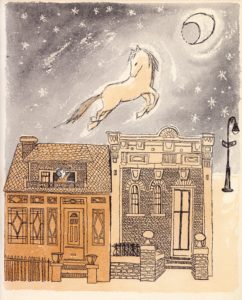
Art from Kenny’s Window, young Maurice Sendak’s picture-book debut about dreams and the parameters of the possible.
Six years before John F. Kennedy asserted in one of the greatest speeches ever given that the artist is society’s foremost voice of resistance against injustice, Camus adds:
Art, by virtue of that free essence I have tried to define, unites whereas tyranny separates. It is not surprising, therefore, that art should be the enemy marked out by every form of oppression. It is not surprising that artists and intellectuals should have been the first victims of modern tyrannies… Tyrants know there is in the work of art an emancipatory force, which is mysterious only to those who do not revere it. Every great work makes the human face more admirable and richer, and this is its whole secret. And thousands of concentration camps and barred cells are not enough to hide this staggering testimony of dignity. This is why it is not true that culture can be, even temporarily, suspended in order to make way for a new culture… There is no culture without legacy… Whatever the works of the future may be, they will bear the same secret, made up of courage and freedom, nourished by the daring of thousands of artists of all times and all nations.
All the essays collected in Camus’s Resistance, Rebellion, and Death vibrate with uncommon insight into art and life that seems to grow timelier with the passage of time. Complement this particular portion with Simone de Beauvoir on the artist’s duty to liberate the present from the past, Ursula K. Le Guin on the power of art and storytelling to transform and redeem, and Toni Morrison on the artist’s task in times of political turmoil, then revisit Camus on what it means to be a rebel, the three antidotes to the absurdity of life, and the most important question of existence.
_______________________________________
 Brain Pickings is the brain child of Maria Popova, an interestingness hunter-gatherer and curious mind at large obsessed with combinatorial creativity who also writes for Wired UK and The Atlantic, among others, and is an MIT Futures of Entertainment Fellow. She has gotten occasional help from a handful of guest contributors. Email: brainpicker@brainpickings.org
Brain Pickings is the brain child of Maria Popova, an interestingness hunter-gatherer and curious mind at large obsessed with combinatorial creativity who also writes for Wired UK and The Atlantic, among others, and is an MIT Futures of Entertainment Fellow. She has gotten occasional help from a handful of guest contributors. Email: brainpicker@brainpickings.org
Go to Original – brainpickings.org
DISCLAIMER: The statements, views and opinions expressed in pieces republished here are solely those of the authors and do not necessarily represent those of TMS. In accordance with title 17 U.S.C. section 107, this material is distributed without profit to those who have expressed a prior interest in receiving the included information for research and educational purposes. TMS has no affiliation whatsoever with the originator of this article nor is TMS endorsed or sponsored by the originator. “GO TO ORIGINAL” links are provided as a convenience to our readers and allow for verification of authenticity. However, as originating pages are often updated by their originating host sites, the versions posted may not match the versions our readers view when clicking the “GO TO ORIGINAL” links. This site contains copyrighted material the use of which has not always been specifically authorized by the copyright owner. We are making such material available in our efforts to advance understanding of environmental, political, human rights, economic, democracy, scientific, and social justice issues, etc. We believe this constitutes a ‘fair use’ of any such copyrighted material as provided for in section 107 of the US Copyright Law. In accordance with Title 17 U.S.C. Section 107, the material on this site is distributed without profit to those who have expressed a prior interest in receiving the included information for research and educational purposes. For more information go to: http://www.law.cornell.edu/uscode/17/107.shtml. If you wish to use copyrighted material from this site for purposes of your own that go beyond ‘fair use’, you must obtain permission from the copyright owner.
